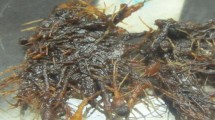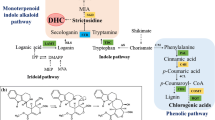Abstract
Morinda royoc L. (Rubiaceae) root cultures were established for the production of anthraquinones (AQs). Three independent experiments were performed to evaluate the effects of different levels of indole-3-acetic acid (0–22.8 μM), culture duration (15–75 days) and subculture number (0–4). The following indicators were recorded: root fresh weight per Erlenmeyer and intracellular and extracellular AQ production. The experiments performed in this study allowed an increase of intracellular AQ content up to a maximum of 4.5 mg g−1 of fresh mass, after 30 days of culture in a medium 5.7 μM of IAA. In addition, isolation and identification of seven AQs from M. royoc L. roots is described, one of them being reported for the first time for this species. The structures of isolated compounds were determined from 1H-NMR data. To the best of our knowledge, this is the first report on AQ production from root culture of this plant.




Similar content being viewed by others
Abbreviations
- AQ(s):
-
Anthraquinone(s)
- FW:
-
Fresh weight
- IAA:
-
Indole-3-acetic acid
- MS:
-
Murashige–Skoog medium
- NAA:
-
1-Naphthaleneacetic acid
- TLC:
-
Thin layer chromatography
- 2,4-D:
-
2,4-Dichlorophenoxyacetic acid
References
Abdullah MA, Ali AM, Marziah M, Lajis NH, Ariff AB (1998) Establishment of cell suspension cultures of Morinda elliptica for the production of anthraquinones. Plant Cell Tissue Organ Cult 54:173–182. doi:10.1023/A:1006108717255
Akinyemi KO, Oladapo O, Okwara CE, Ibe CC, Fasure KA (2005) Screening of crude extracts of six medicinal plants used in South-West Nigerian unorthodox medicine for anti-methicillin resistant Staphylococcus aureus activity. BMC Complement Altern Med. http://www.biomedcentral.com/1472-6882/5/6
Balandrin MJ, Klocke JA (1988) Medicinal, aromatic and industrial materials from plants. In: Bajaj YPS (ed) Biotechnology in agriculture and forestry 4. Medicinal and aromatic plants I. Springer-Verlag, Berlin, Heidelberg, pp 1–36
Bulgakov VP, Tchernoded GK, Mischenko NP, Khodakovskaya MV, Glazunov VP, Radchenko SV et al (2002) Effect of salicylic acid, methyl jasmonate, ethephon and cantharidin on anthraquinone production by Rubia cordifolia callus cultures transformed with the rolB and rolC genes. J Biotechnol 97:213–221. doi:10.1016/S0168-1656(02)00067-6
Cai Y, Luo Q, Sun M, Corke H (2004) Antioxidant activity and phenolic compounds of 112 traditional Chinese medicinal plants associated with anticancer. Life Sci 74:2157–2184. doi:10.1016/j.lfs.2003.09.047
Chong TM, Abdullah MA, Fadzillah NM, Lai OM, Lajis NH (2004) Anthraquinones production, hydrogen peroxide level and antioxidant vitamins in Morinda elliptica cell suspension cultures from intermediary and production medium strategies. Plant Cell Rep 22:951–958. doi:10.1007/s00299-004-0793-z
Chong TM, Abdullah MA, Lai OM, Nor’Aini FM, Lajis NH (2005) Effective elicitation factors in Morinda elliptica cell suspension culture. Process Biochem 40:3397–3405. doi:10.1016/j.procbio.2004.12.028
George EF (1993) Plant propagation by tissue culture. Exegetics limited, Edington
Hagendoorn MJM, van der Plas LHW, Segers GJ (1994) Accumulation of anthraquinones in Morinda citrifolia cell suspensions. A model system for the study of the interaction between secondary and primary metabolism. Plant Cell Tissue Organ Cult 38:227–234. doi:10.1007/BF00033881
Han Y-S, van der Heijden R, Verpoorte R (2001) Biosynthesis of anthraquinones in cell cultures of the Rubiaceae. Plant Cell Tissue Organ Cult 67:201–220. doi:10.1023/A:1012758922713
Han Y-S, van der Heijden R, Lefeber AWM, Erkelens C, Verpoorte R (2002) Biosynthesis of anthraquinones in cell cultures of Cinchona ‘Robusta’ proceeds via the methylerythritol 4-phosphate pathway. Phytochemistry 59:45–55. doi:10.1016/S0031-9422(01)00296-5
Kanokmedhakul K, Kanokmedhakul S, Phatchana R (2005) Biological activity of anthraquinones and triterpenoids from Prismatomeris fragrans. J Ethnopharmacol 100:284–288. doi:10.1016/j.jep. 2005.03.018
Khouri HE, Ibrahim RK, Rideau M (1986) Effects of nutritional and hormonal factors on growth and production of anthraquinone glucosides in cell suspension cultures of Cinchona succirubra. Plant Cell Rep 5:423–426. doi:10.1007/BF00269632
Komaraiah P, Kavi Kishor PB, Carlsson M, Magnusson K-E, Mandenius C-F (2005) Enhancement of anthraquinone accumulation in Morinda citrifolia suspension cultures. Plant Sci 168:1337–1344. doi:10.1016/j.plantsci.2005.01.017
Murashige T, Skoog F (1962) A revised medium for rapid growth and bioassays with tobacco tissue cultures. Physiol Plant 15:473–497. doi:10.1111/j.1399-3054.1962.tb08052.x
Muzychkina RA (1998) Natural anthraquinones: biological and physicochemical properties. PHASIS, Moscow
Park YH (1977) Part I: A phytochemical study of Morinda roioc L. (family Rubiaceae). Part II: Alkaloids in aged potatoes, Solanum tuberosum L. (family Solanaceae). Dissertation, University of Mississippi
Pérez C (2005) Técnicas estadísticas con SPSS 12. Aplicaciones al análisis de datos. ISBN 84-205-4410-8. Pearson Educación SA (ed), Spain
Ramos-Valdivia AC, van der Heijden R, Verpoorte R (1997) Elicitor-mediated induction of anthraquinone biosynthesis and regulation of isopentenyl diphosphate isomerase and farnesyl diphosphate synthase activities in cell suspension cultures of Cinchona robusta. Planta 203:155–161. doi:10.1007/s004250050177
Sato K, Yamazaki T, Okuyama E, Yoshihira K, Shimomura K (1991) Anthraquinone production by transformed root cultures of Rubia tinctorum: influence of phytohormones and sucrose concentration. Phytochemistry 30:1507–1509. doi:10.1016/0031-9422(91)84198-2
Scull I, Cabrera MY, Cabrera I (2000) Suplemento alimenticio de origen natural y su procesamiento de obtención. Cuba Patente CU22628:A1
Semple SJ, Pyke SM, Reynolds GD, Flower RLP (2001) In vitro antiviral activity of the anthraquinone chrysophanic acid against poliovirus. Antiviral Res 49:169–178. doi:10.1016/S0166-3542(01)00125-5
Thomson RH (1996) Naturally occuring quinones IV. Chapman and Hall, London
Wijnsma R, Go JTKA, Harkes PAA, Verpoorte R, Baerheim Svendsen A (1986) Anthraquinones in callus cultures of Cinchona pubescens. Phytochemistry 25:1123–1126. doi:10.1016/S0031-9422(00)81567-8
Zenk MH, EI-Shagi H, Schulte U (1975) Anthraquinone production by cell suspension cultures of Morinda citrifolia. Planta Med Suppl 79–101
Acknowledgements
This research was supported by a Fundación Carolina fellowship, a MEC grant (AGL2004-05252), and Cuban CITMA funds. The authors are grateful to Dr. José Carlos Lorenzo (Centro de Bioplantas, Cuba) for his critical reading of the manuscript.
Author information
Authors and Affiliations
Corresponding author
Rights and permissions
About this article
Cite this article
Borroto, J., Coll, J., Rivas, M. et al. Anthraquinones from in vitro root culture of Morinda royoc L.. Plant Cell Tiss Organ Cult 94, 181–187 (2008). https://doi.org/10.1007/s11240-008-9403-z
Received:
Accepted:
Published:
Issue Date:
DOI: https://doi.org/10.1007/s11240-008-9403-z




